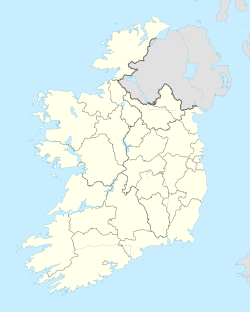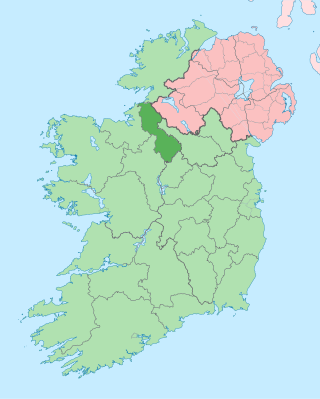
County Leitrim is a county in Ireland. It is in the province of Connacht and is part of the Northern and Western Region. It is named after the village of Leitrim. Leitrim County Council is the local authority for the county, which had a population of 35,199 according to the 2022 census.

Carrick-on-Shannon is the county town of County Leitrim in Ireland. It is the largest town in the county of Leitrim. A smaller part of the town lies in County Roscommon. As of the 2022 census, the population of the town was 4,743. It is situated on a strategic crossing point of the River Shannon. The Leitrim part of the town is in the civil parish of Kiltoghert which is in the ancient barony of Leitrim.

Sligo is a coastal seaport and the county town of County Sligo, Ireland, within the western province of Connacht. With a population of 20,608 in 2022, it is the county's largest urban centre and the 24th largest in the Republic of Ireland.

Askeaton is a town in County Limerick, Ireland. The town is built on the banks of the River Deel which flows into the Shannon Estuary 3 km to the north. Askeaton is on the N69 road between Limerick and Tralee; it is 25 km west of Limerick and 8 km north of Rathkeale. The town is in a townland and civil parish of the same name.

Ballinamore is a small town in the south-east of County Leitrim in Ireland.

Manorhamilton is the second-largest town in County Leitrim, Ireland. It is located on the N16 26 kilometres (16 mi) from Sligo and 41 kilometres (25 mi) from Enniskillen.

Buttevant is a medieval market town in County Cork, Ireland.

Dromod is a village in County Leitrim, Ireland. Dromod is a noted fishing village beside Bofin and Boderg, which are threaded by the River Shannon. Built along the River Shannon, this is a Tidy Towns winner with a modern harbour frequented by cruiser traffic. The Bog Oak water feature in the centre of the village, entitled 'The Weeping Tree', and was made by a local craftsman from a piece of bog oak which was found nearby.

Drumshanbo is a small town situated in the heart of County Leitrim, Ireland. Drumshanbo is surrounded by a scenic area of soft rolling hills, woodlands, lakes and the Sliabh an Iarainn and Arigna mountains. It is a well preserved town with traditional pubs, shops, and restaurants.

Mohill is a town in County Leitrim, Ireland. The town of Carrick-on-Shannon is approximately 16 km (10 miles) away.

Dromahair is a village in County Leitrim, Ireland. Dromahair is 10 km (6 mi) from Manorhamilton and 17 km (10 mi) from Sligo town.
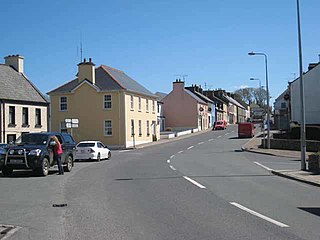
Drumkeeran, also Drumkeerin, is a village and townland in County Leitrim, Ireland, located at the junction of the R280 and R200 roads. It is situated in drumlin hills at the foot of Corry Mountain, just north of Lough Allen.

Drumsna is a village in County Leitrim, Ireland. It is situated 6 km east of Carrick-on-Shannon on the River Shannon and is located off the N4 National primary route which links Dublin and Sligo. The harbour dates to 1817 and was a hive of commercial waterway activity until the more northern navigation canal to Carrick-on-Shannon was opened in 1850. Today, the waterway is busy with anglers and tourist pursuits in the summer months.
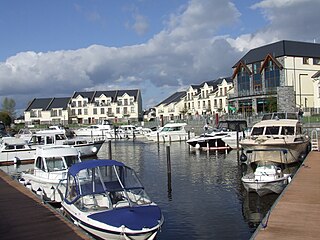
Leitrim is a village in County Leitrim, Ireland, on the River Shannon near the border with County Roscommon. It is at the junction of the R280 and R284 regional roads.
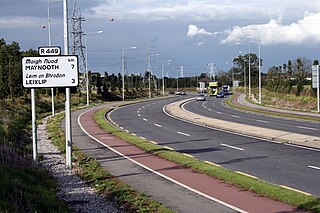
A regional road in the Republic of Ireland is a class of road not forming a major route, but nevertheless forming a link in the national route network. There are over 11,600 kilometres of regional roads. Regional roads are numbered with three-digit route numbers, prefixed by "R". The equivalent road category in Northern Ireland are B roads.

Blacklion is a border village in west County Cavan, Ireland. It is situated on the N16 national primary road, just across the border from the County Fermanagh village of Belcoo.

Parke's Castle is a 17th century semi-fortified manor house. It is situated on the north-eastern shore of Lough Gill, in the north of County Leitrim, in the northwest of Ireland. The castle is built on the site of an earlier 16th Century O'Rourke Gaelic tower house. The castle and bawn had come into the possession of Captain Robert Parke by 1628, possibly earlier. He had been granted some of the former O'Rourke lands as part of the Plantations. By 1635, Parke had completed his fortified manor house on the site of the older Gaelic castle.
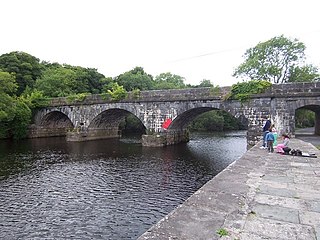
Knockvicar is a village in County Roscommon, Ireland. It is located on the R285 regional road, between Boyle and Carrick-on-Shannon near Lough Key Forest Park in the north of the county.

The barony of Leitrim is a barony in County Leitrim, Ireland.

